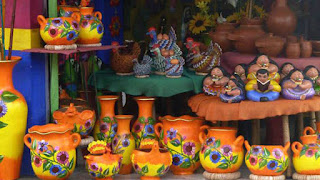THE CULTURE OF EL SALVADOR
The culture
of El Salvador is a mixture of the Maya, Lenca, Nahua, Ulua, Spanish and other
minority ethnic cultures.
Less than
1% of the population speaks Nahuatl. The Catholic religion played an important
role in the culture of El Salvador. Articles of painting, ceramics and textiles
are the main manual artistic expressions. Writers Francisco Gavidia
(1863-1955), Alberto Masferrer, Salarrué, Claudia Lars, Alfredo Espino, Pedro
Geoffroy Rivas and Manlio Argueta, poet Roque Dalton and are among the most
important artists from El Salvador.
Dresses
In El
Salvador there are different types of costumes, in which most are used in
different festivities, although some people still use them. In the women's
costume it is common to see elements like a scapular, a shawl, a cloth and
different colored ornaments in footwear sandals are used. In the male costume
is common to see a cotton suit, also in traditional festivals, used modern
jeans with a cotton shirt, shoes in sandals or boots, and a hat. They really
are rural in character, and have different variations depending on location.
In El
Salvador the official language is Spanish. The speech can mix words of
indigenous origin, causing what are the different idioms. A small amount of the population speaks pipil language, as in
Izalco and other towns, currently does not take the need for learn, or only
remembered by older people. Among the pre-Columbian languages are chorotega,
Cacaopera, Chorti language, language Xinca, Lenca, Pocomam language.
Dance
 They are
the popular dances that fulfill a social function, one of the most famous
dances is the "Torito Pinto". are also "Carnival of San
Miguel", "Adentro Cojutepeque," "Ahuachapan," "El
Carbonero" ... They are the most popular. There are others such as
"Las cortadoras", "Las floreras de El Boqueron" among
others. These dances comprise much of Salvadoran culture. The raditional dresses
are used in this kind of dances and can represent different historical events
or rural activities, such as agriculture. They are danced by several couples.
They may have different choreography depending on what is to be displayed,
accompanied by traditional music. They are usually held at different times and
in different places . The classification of these dances is indigenous and
traditional.
They are
the popular dances that fulfill a social function, one of the most famous
dances is the "Torito Pinto". are also "Carnival of San
Miguel", "Adentro Cojutepeque," "Ahuachapan," "El
Carbonero" ... They are the most popular. There are others such as
"Las cortadoras", "Las floreras de El Boqueron" among
others. These dances comprise much of Salvadoran culture. The raditional dresses
are used in this kind of dances and can represent different historical events
or rural activities, such as agriculture. They are danced by several couples.
They may have different choreography depending on what is to be displayed,
accompanied by traditional music. They are usually held at different times and
in different places . The classification of these dances is indigenous and
traditional.
Handicraft
In El Salvador you can find a huge variety of crafts of excellent quality made by residents, Such crafts can be made from a variety of materials such as iron, clay, wood carving and straw.
You can find all of this Handicraft at Panchimalco, Ilobasco, La Palma Chalatenango and Apaneca.



No hay comentarios.:
Publicar un comentario